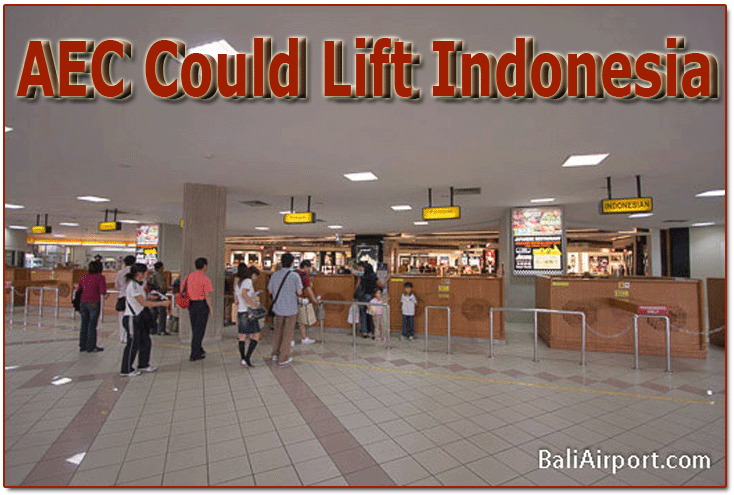
Could Indonesia be the big winner in the
economic integration of South East Asia? Well, yes, but only if it implements
a raft of new reforms to encourage private investment in infrastructure
and to improve the flow of goods across borders.
On entering Bali’s brand new, but
frustratingly inefficient, Ngurah Rai International Airport after a flight
from Singapore, there is a new immigration queue. It’s exclusively
for use by nationals of the ten-member ASEAN bloc—Brunei Darussalam,
Cambodia, Indonesia, Laos, Malaysia, Myanmar, Philippines, Singapore,
Thailand, and Vietnam. This is the first tangible sign your correspondent
has seen while touring South East Asia of the ASEAN Economic Community,
which was originally due to be launched at the start of January but has
now been delayed by a year.
 The
thinking behind AEC is to create a cohesive single market for labor, goods,
and services covering a combined population of more than 620 million—in
effect Asia’s equivalent of the European Union. By opening borders
and aligning customs duties, the AEC could attract huge amounts of investment
by manufacturers and their logistics partners as they seek out new markets
and centers for production. An open skies deal across the ASEAN region
has not been fully signed off, but it is due to come into force later
this year as part of the launch of AEC. The
thinking behind AEC is to create a cohesive single market for labor, goods,
and services covering a combined population of more than 620 million—in
effect Asia’s equivalent of the European Union. By opening borders
and aligning customs duties, the AEC could attract huge amounts of investment
by manufacturers and their logistics partners as they seek out new markets
and centers for production. An open skies deal across the ASEAN region
has not been fully signed off, but it is due to come into force later
this year as part of the launch of AEC.
“We are monitoring the progress of
the AEC very closely, especially on the key pillar ‘Single Market
and Production Base,’ including Open Skies and Free Flow of Goods,”
said Li Wenjun, head of Air Freight in the Asia Pacific region at DHL
Global Forwarding.
“We regard the ASEAN market as an
unpolished gem with plenty of opportunities and strongly believe that
the AEC will allow ASEAN to fulfill its true potential. At the current
stage of implementation for AEC, we see positive steps taken, including
the Open Skies Agreement and customs system/process integration.
“We expect the benefits of the AEC
to come through in the next few years when the systems and processes become
more mature and have stabilized.
“Open skies in Asia Pacific will help
the logistics industry in terms of capacity while we keep an open mind
on its effects on respective countries and the economy at large.”
In theory, Indonesia, with a population
of 250 million and South East Asia’s largest economy, has most to
gain from AEC and Open Skies. And its airlines such as Garuda and Lion
Air have been among the most aggressive airlines in the world when it
comes to placing new aircraft orders.
 |
One study by analysts at Mott MacDonald for the Indonesian
government estimated that Open Skies would generate around 2.9 trillion
Rupiah ($2.23 billion) in additional direct Gross Domestic Product and
an additional 16,000 direct jobs by 2025. If indirect and induced effects
were included, these differentials increased to around 6.3 trillion Rupiah
and 29,000 jobs.
But a liberalized air market in South East
Asia would also see the Indonesian market opened up to Malaysia’s
low cost carriers and Singapore’s well-funded airlines. And their
regional rivals have also been investing in new planes. More critically,
they have been opening something that Indonesia currently lacks—sufficient
capacity. Changi Airport’s Terminal 4 will be ready in 2017 and
a fifth terminal is scheduled for the middle of the next decade, while
KLIA II is now also operational. The picture in Indonesia is rather different.
In short, to realize the gains identified
by Mott McDonald, Indonesia needs huge investment. Apart from lacking
parking spots, runways, and terminals for the new airplanes hoping to
soon operate in its airspace, pilots and skilled personnel are also in
short supply.
Indonesia’s ability to safely manage
its air traffic is another issue of concern since the December 28 crash
of AirAsia flight QZ8501, en route from Surabaya to Singapore, killed
all 162 people on board.
Another worry is that the Center for Aviation
(CAPA) believes that Indonesia’s airline sector is over-regulated
to such an extent that it questions whether it is equipped to thrive in
a fully liberalized market. Earlier this year the Center called for more
investment in infrastructure and less government involvement in the sector.
CAPA also noted that the Indonesian aviation sector had undergone a doubling
in size over the past five years, but growth slowed in 2014 with almost
all airlines failing to turn a profit.
 David
Buckby, a researcher at consultant Transport Intelligence who recently
co-authored Ti’s ‘Indonesia Transport & Logistics 2015
– A New Dawn?’ report, said there had been investment in new
passenger facilities and airport capacity at hubs including Jakarta, Bali,
Medan, and Labuan Bajo/Komodo. But in many cases tender processes had
lacked transparency and the results had been less than desirable. In some
cases the new capacity had been entirely filled within months of opening. David
Buckby, a researcher at consultant Transport Intelligence who recently
co-authored Ti’s ‘Indonesia Transport & Logistics 2015
– A New Dawn?’ report, said there had been investment in new
passenger facilities and airport capacity at hubs including Jakarta, Bali,
Medan, and Labuan Bajo/Komodo. But in many cases tender processes had
lacked transparency and the results had been less than desirable. In some
cases the new capacity had been entirely filled within months of opening.
“What is clear is that Indonesia desperately
needs more air capacity,” said Buckby. “Domestic and international
cargo and passenger growth have been growing rapidly for the last decade,
but infrastructure is a long way behind.”
The new government of President Joko Widodo,
commonly known as Jokowi, has pledged to raise finance via public-private
partnerships to build or upgrade ten regional airports. The old Halim
Perdanakusuma city airport was also re-opened last year for domestic flights,
has cargo capacity, and features distribution centers operated by DHL
and UPS’ partner Cardig Logistics.
Faith has also been placed in the aerotropolis
concept. State-run airport operator P.T. Angkasa Pura II plans to use
the concept to develop North Sumatra's Kuala Namu International Airport
as an integrated facility tied to Belawan Port and Kuala Tanjung Port
in a bid to spur economic growth and boost usage of nearby special economic
zones.
But plans for a second airport at Jakarta’s
Soekarna-Hatta International Airport are moving forward very slowly.
Buckby said international ground handlers
were eyeing Indonesia’s burgeoning international and domestic freight
markets with interest, but for the most part had kept their distance until
the investment environment became more transparent.
“Jokowi needs to make attracting investment
and expertise a priority,” he added. “If he does not, then
Indonesia might be left out while its regional rivals benefit from Open
Skies and free trade.”
SkyKing |





